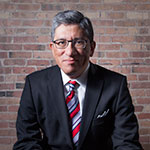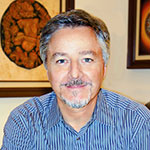East Los Angeles is known as one of Southern California’s most impoverished communities. Real estate attorney Alfred Fraijo, however, is proof that there’s more to East LA than the poverty statistics, sound bites, and stereotypes. Fraijo personally understands the deep character, culture, and conviction within the community.
A native of the Boyle Heights neighborhood, he grew up surrounded by violence but was shaped more by his community’s assets than its deficits. His father, a truck driver, and his mother, a Mexican immigrant, taught him working-class values like hard work, scholarship, and service. These values led to his earning a bachelor’s degree from Harvard University and a law degree from Loyola Marymount University. Now a partner in the Los Angeles office of Sheppard, Mullin, Richter & Hampton LLP, where he leads the firm’s real estate, land use, and natural resources practice group, Fraijo has dedicated his career to improving Boyle Heights and other underserved communities in the area. His instrument for doing so—commercial real estate—is surprising, yet effective.
Sheppard Mullin
By-the-Numbers
100,000
Population of Boyle Heights, the East LA neighborhood where Alfred Fraijo grew up.
44 acres
The size of a planned park over US Route 101 in Los Angeles for which Fraijo serves as land use and real estate counsel.
$500 million
The cost of the Millennium Hollywood project Fraijo represents, a mixed-use development around the Capitol Records building in Hollywood, representing nearly $1 billion of new investment in the City of Los Angeles.
932
The capacity of the historic TCL Chinese Theatre in Hollywood, which underwent a multimillion-dollar renovation, legally managed by Fraijo in 2013.
It seems that you’ve succeeded, not in spite of where you’re from, but because of it. How did your childhood in East LA shape you?
My mother immigrated to the United States with my grandmother, who was a farm worker, and my father was first-generation Mexican-American. My parents settled in Boyle Heights. It’s a predominantly Mexican-American community that has a really interesting immigrant history. For several generations, it was the second-largest Jewish community in the United States, after Brooklyn, until it became predominantly Japanese-American, and then, ultimately, Mexican-American. I mention that because it was an important element of my upbringing. It’s a community with a rich history of diversity and transformation, which in many ways is also my story.
Because I grew up in a working-class community that was culturally connected to the immigrant experience, I have always identified with the struggle of being disenfranchised and marginalized. When I think about my grandmother and how much she worked, I feel a sense of moral obligation to make a difference not just for my family, but for the folks who are in my community who came to the United States seeking a better opportunity for themselves and their children.
How did you decide that real estate would be a good vehicle for effecting change?
I originally wanted to be a civil rights lawyer. I went to school on a full scholarship to launch my career in that area. I then got the opportunity to spend a summer working for a nonprofit in the San Francisco Bay Area that was doing a lot of work around environmental justice. That exposed me to real estate development and land use. I found a nexus between community development, social justice, real estate, and the environmental field. Environmental justice is an important component of social justice in regards to some of the issues that are challenging for our community. The perceived status of properties in the urban core as contaminated properties or potentially contaminated properties, for instance, actually hinders the reuse of underutilized parcels.
That’s what I’m currently focused on in my work as a real estate attorney: I take underutilized properties and find new uses for them that are beneficial and catalytic to communities that are underserved.
As an attorney, do you ever feel like you have to choose between your clients’ interests and those of communities?
Right now there’s gentrification happening throughout Los Angeles. There are economic developments that are changing the character of what used to be primarily working-class or immigrant communities, and that’s creating tension. Rather than being entirely opposed to gentrification or change, I’ve focused my work with developers on using change as a tool for renewal within communities that are struggling because they’re underserved either by retail or by a lack of affordable housing. Accessible housing opportunities can provide a critical anchor to stabilize residents in communities experiencing demographic and economic changes. As an expert in the area of real estate development, I have a unique role in that I’m able to combine the interests of different stakeholder groups. I see myself as an urban diplomat in many ways, being able to provide a bridge between business and community.
Can you offer an example that illustrates the kind of “urban diplomacy” you practice?
In south central Los Angeles there was a heavy industrial site that was vacant for many years. Along with my client, I worked on a redevelopment plan that required a public-private partnership. What we ended up being able to do as a result of that partnership was create a new commercial center that has an array of uses—restaurant, retail, and commercial—in an area that was vastly underserved. Obviously, that project generated new jobs because it took a once-vacant, 30-acre parcel and transformed it into a thriving, commercial center with shops and amenities and places for the community to gather.
Your community development mission extends into your personal life— you spend your free time volunteering for organizations such as the Leadership for Urban Renewal Network and Friends of the Hollywood Freeway Central Park. How do these causes enhance the communities in which you work?
I founded the Leadership for Urban Renewal Network along with other young professionals in 2008. It’s a multidisciplinary group of professionals working in areas such as community organizing, redevelopment, real estate finance, and urban planning. The idea behind our vision was: How do we leverage our expertise to create a laboratory for testing creative ideas that could help disenfranchised communities? We work on issues, for instance, that support microenterprises at the local level. We also adapt the traditional venture capital model to reinvest in small businesses in urban communities.
Friends of the Hollywood Freeway Central Park is an organization whose sole mission is to build a park over US Route 101. We’re proposing a mile-long, 44-acre park over one of the busiest freeways in America. Our goal is to create open space for one of the areas that is the most park-poor in California.
Clearly, you’re a man with a mission. What’s your message?
We need to find thoughtful, culturally sensitive, and creative solutions to bring market forces to bear in ways that are beneficial to struggling communities. I know there is a way to do that because I do it every day.

